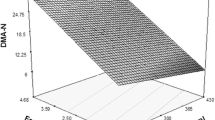Abstract
Slurry ice is a biphasic system consisting of small spherical ice crystals surrounded by seawater at subzero temperature. Its employment was evaluated in the present work as a new chilled storage method for whole European Hake (Merluccius merluccius) and compared to traditional flake icing. Different chemical analyses (nucleotide degradation, formaldehyde formation, lipid hydrolysis and oxidation, interaction compound formation, and electrophoretic protein profiles) related to quality changes were analysed and compared to sensory evaluation. An inhibitory effect on quality loss mechanisms was observed for the slurry ice treatment, according to nucleotide degradation (K value), free formaldehyde content, browning development, and sarcoplasmic protein profiles. No differences in lipid hydrolysis and oxidation could be distinguished by a comparison between both icing conditions. The sensory analysis showed a higher shelf-life time for slurry icing than flake icing (12 days and 5 days, respectively). Results confirm the practical advantages of using slurry ice as a chilled storage method.

Similar content being viewed by others
References
Whittle K, Hardy R, Hobbs G (1990) Chilled fish and fishery products. In: Gormley T (ed) Chilled foods: the state of the art. Elsevier, New York, pp 87–116
Ashie I, Smith J, Simpson B (1996) Crit Rev Food Sci 36:87–121
Love R (1997) Biochemical dynamics and the quality of fresh and frozen fish. In: Hall G (ed) Fish processing technology. Blackie, London, pp 1–31
Nunes M, Batista I, Morâo de Campos R (1992) J Sci Food Agr 59:37–43
Kraus L (1992) Refrigerated sea water treatment of herring and mackerel for human consumption. In: Burt J, Hardy R, Whittle K (eds) Pelagic fish: the resource and its exploitation. Fishing News, Aberdeen, Scotland, pp 73–81
Ponce de León S, Inoue N, Shinano H (1993) Bull Fac Fish Hokkaido Univ 44:80–85
Hwang K, Regenstein J (1995) J Aquat Food Prod Technol 4:19–30
Chapman L (1990) Aust Fish 7:16–19
Harada K (1991) Aust Fish 2:28–30
Huidobro A, López-Caballero M, Mendes R (2002) Z Lebensm Unters For 214:469–475
Price R, Melvin E, Bell J (1991) J Food Sci 56:318–321
Martinsdóttir E, Valdimarsdóttir P, Porkelsdóttir A, Olafsdóttir G, Tryggvadóttir S (2002) Shelf life of sea bass (Dicentrarchus labrax) in liquid and flake ice studied by quality index method (QIM), electronic nose and texture. In: Proc 32nd Annual WEFTA Meeting, Galway, Ireland, 12–15 May 2002
Huidobro A, Mendes R, Nunes M (2001) Z Lebensm Unters For 213:267–272
Chinivasagam H, Bremner H, Wood A, Nottingham S (1998) Int J Food Microb 42:45–55
FAO Inform (2003) Fishery statistics. In: FAO Yearbook 2001, vol 93. FAO, Rome, p 104
Bligh E, Dyer W (1959) Can J Biochem Phys 37:911–917
Lowry R, Tinsley I (1976) J Am Oil Chem Soc 53:470–472
Chapman R, McKay J (1949) J Am Oil Chem Soc 26:360–363
Aubourg S, Sotelo C, Gallardo J (1997) J Food Sci 62:295–298, 304
Aubourg S, Rey-Mansilla M, Sotelo C (1999) Z Lebensm Unters For 208:189–193
Hassan I, Khallaf M, Abd-El Fattah L, Yasin N (1999) Grasas Aceites 50:208–217
Ryder J (1985) J Agr Food Chem 33:678–680
Rey-Mansilla M, Sotelo C, Aubourg S, Rehbein H, Havemeister W, Jorgensen B, Nielsen M (2001) Eur Food Res Technol 213:43–47
Nash T (1953) Biochem J 55:416–421
Piñeiro C, Barros-Velázquez J, Sotelo C, Pérez-Martín R, Gallardo J (1998) J Agr Food Chem 46:3991–3997
Comunidades Europeas (1989) Baremo de clasificación de frescura. In: Diario oficial de las Comunidades Europeas, no L 5/21. Comunidades Europeas, Brussels, pp 5–6
Rodríguez Ó, Barros-Velázquez J, Ojea A, Piñeiro C, Aubourg S (2003) J Food Sci 68:2764–2771
Statsoft (1994) Statistica for Macintosh. Statsoft and its licensors, Tulsa, Oklahoma, USA
Ruiz-Capillas C, Moral A (2001) Food Res Int 34:441–447
Rehbein H (1988) J Sci Food Agr 43:261–276
Sotelo C, Piñeiro C, Pérez-Martín R (1995) Z Lebensm Unters For 200:14–23
Aubourg S (2001) J Am Oil Chem Soc 78:857–862
Aubourg S, Medina I, Gallardo J (1998) J Agr Food Chem 46:3662–3666
Undeland I, Hall G, Lingnert H (1999) J Agr Food Chem 47:524–532
Aubourg S (1998) Z Lebensm Unters F A 206:29–32
Aubourg S (1998) Z Lebensm Unters F A 207:268–272
Morzel M, Vérrez-Bagnis V, Arendt E, Fleurence J (2000) J Agr Food Chem 48:239–244
Papa I, Álvarez C, Vérrez-Bagnis V, Fleurence J, Benyamin Y (1996) J Sci Food Agr 72:63–70
Vérrez-Bagnis V, Noël J, Sautereau J, Fleurence J (1999) J Food Sci 64:240–242
Baixas-Nogueras S, Bover-Cid S, Veciana-Nogués T, Vidal-Carou C (2002) J Agr Food Chem 50:6504–6510
Acknowledgements
The authors wish to thank KINARCA S.A.U. for providing the slurry ice equipment. This work was supported by the Secretaría Xeral de I + D from the Xunta de Galicia (Galicia, Spain) (Project PGIDTI02RMA18E). The authors also thank Mr. Marcos Trigo, Mr. José M. Antonio and Mrs. Lorena Barros for their excellent technical assistance.
Author information
Authors and Affiliations
Corresponding author
Rights and permissions
About this article
Cite this article
Losada, V., Piñeiro, C., Barros-Velázquez, J. et al. Effect of slurry ice on chemical changes related to quality loss during European Hake (Merluccius merluccius) chilled storage. Eur Food Res Technol 219, 27–31 (2004). https://doi.org/10.1007/s00217-004-0914-5
Received:
Revised:
Published:
Issue Date:
DOI: https://doi.org/10.1007/s00217-004-0914-5




